Page 319 of 352 pages « First < 317 318 319 320 321 > Last »
Slave tag
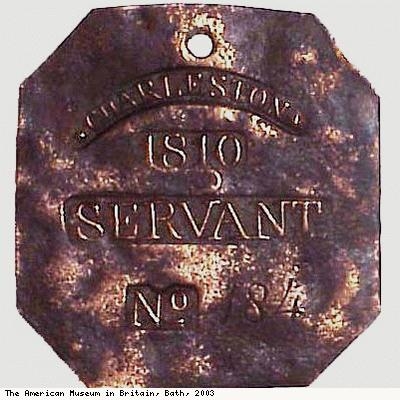
Description:
Slave tag, worn for identification. Copper servant (slave) tag No. 184. The tag belonged to a slave called Lafar (his touch mark is on back). The earliest known servant tag from Charleston . Found in New York State, at the end of so-called Underground Railroad which smuggled slaves out of the South.
Contributed by John Judkyn Memorial.
Date: unknown
Copyright: The American Museum in Britain, Bath
Object ID:69.11
Slave pens
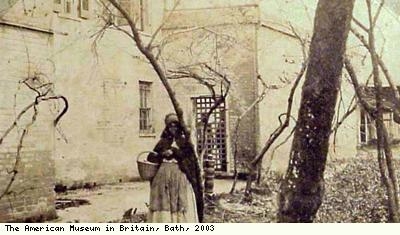
Description:
Framed photograph of slave pens in Alexandria, Virgininia, America. The picture shows a slave woman with basket. Text printed at the bottom face of photograph: Entered according to act of Congress in the year 1862, by M B Brady, in the Clerks Office of the District Court of the District of Columbia.
Contributed by John Judkyn Memorial.
Date: 1862
Copyright: The American Museum in Britain, Bath
Object ID:64.618
Old Plantation
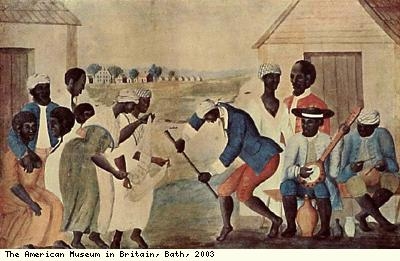
Description:
Framed print, Old Plantation .
Contributed by John Judkyn Memorial.
Date: unknown
Copyright: The American Museum in Britain, Bath
Object ID:64.468.10
Slave bill
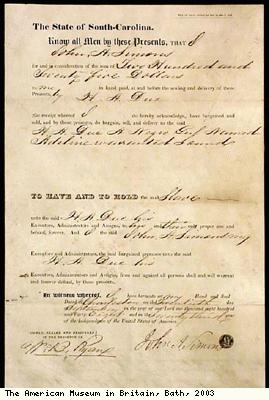
Description:
Framed slave bill of sale from the State of Carolina, America, regarding the sale of the slave Adeline.
Contributed by John Judkyn Memorial.
Copyright: The American Museum in Britain, Bath
Object ID:65.110
Book of poems, title page
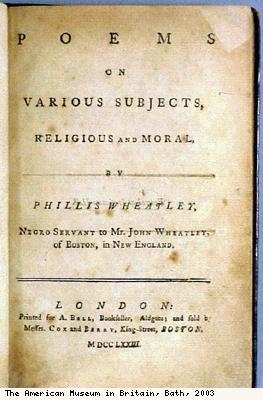
Description:
Title page of book of poems by Phillis Wheatley.
The page reads, Poems on various subjects, religious and moral, by Phillis Wheatley, Negro servant to Mr John Wheatley, of Boston, New England.
Phillis Wheatley was enslaved at the age of about eight, and taken from Africa to America. She was taught to read by the Wheatley family, learning very fast and began to write. The book begins with a list of reputable people from Boston certifying that the poems were written by Phillis Wheatley, as many people did not believe that a black slave could write so well. Her poems often reflect her adopted Christian religion.
Contributed by John Judkyn Memorial.
The language used to describe people of African descent in the 18th, 19th and 20th centuries is unacceptable in today’s terms. We cannot avoid using this language in its original context. To change the words would impose 20th century attitudes on history.
Creator: Phillis Wheatley
Date: 1773
Copyright: The American Museum in Britain, Bath
Object ID:73.236
Learning is Wealth
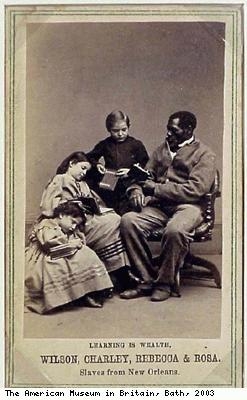
Description:
Framed photograph of slaves from New Orleans: Wilson, Charley, Rebecca and Rosa, Learning is Wealth .
Contributed by John Judkyn Memorial.
Copyright: The American Museum in Britain, Bath
Object ID:65.193.6
Civil War Cover

Description:
Civil War Cover, Treason.
Civil War Covers are envelopes printed during or subsequent to the Civil War, that depict various scenes and themes. Many are of a patriotic nature, and were used to send US Mail, or simply as souvenirs.
Publication of Civil War envelopes began as early as the mid-1850’s, when north-south divisions began to take shape, but ended prior to the war’s conclusion because most believed that it was too indulgent and expensive to continue production in a time of war.
This envelope, having been printed in Cincinnati, Ohio USA, was produced by the North, so is giving an anti-slavery message.
The caption underneath the picture reads:
We is de innocent root ob dis yere trubble, Mass Jeff, but its gwine to take all us poor niggas breff away to keep de wind in it.
The American Civil War began in 1861. It was fought mainly over the issue of whether the different states in the Union had the right to allow slavery in their own state. Most of the southern states supported slavery, most of the northern states were opposed to it. The war ended in 1865, and slavery was abolished throughout the United States.
The language used to describe people of African descent in the 18th, 19th and 20th centuries is unacceptable in today’s terms. We cannot avoid using this language in its original context. To change the words would impose 20th century attitudes on history.
Contributed by John Judkyn Memorial.
Date: c1800s
Copyright: The American Museum in Britain, Bath
Object ID:65.205.5
Symbols of some southern American states

Description:
Framed print of symbols depicting the southern states of Virginia, South Carolina, Louisiana, North Carolina, Georgia and Alabama, all in America. Below are pictured slaves picking cotton.
Contributed by John Judkyn Memorial.
Date: unknown
Copyright: The American Museum in Britain, Bath
Object ID:No. 66.49
Anti-slavery pamphlet (detail)
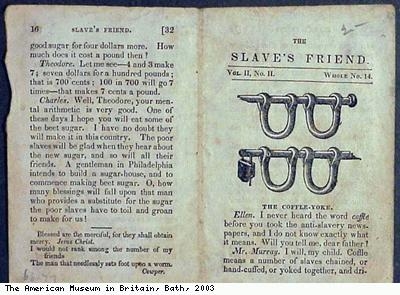
Description:
Volume 2, number 2 of an anti-slavery pamphlet, called The Slaves Friend. Framed.
The article shown on the right of this detail is called The Coffle Yoke.
Slaves would have a U-shaped piece of metal, or yoke , put around their necks. The yoke was attached to a long pole. The pole contained a number of yokes, each holding one slave.This meant that the slaves were chained together by their necks in a line, or coffle . There is an illustration of a coffle yoke at the top of the page.
The article The Coffle Yoke features a father, Mr Murray, explaining to his daughter, Ellen, what a coffle yoke is.The page reads:
Ellen: I never heard the word coffle before you took the anti-slavery newspapers, and I do not know exactly what it means. Will you tell me, dear father?
Mr Murray: I will, my child. Coffle means a number of slaves chained, or handcuffed, or yoked together…
Contributed by John Judkyn Memorial.
Copyright: The American Museum in Britain, Bath
Object ID:66.77
Cotton Pickers Nooning

Description:
Framed photograph: print, Cotton Pickers Nooning.
Contributed by John Judkyn Memorial.
Copyright: The American Museum in Britain, Bath
Object ID:66.78.11
Page 319 of 352 pages « First < 317 318 319 320 321 > Last »

